Understanding the Signs of a Ruptured Eardrum
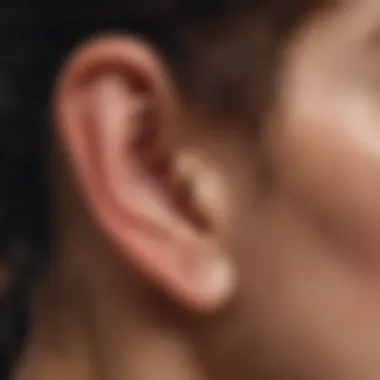
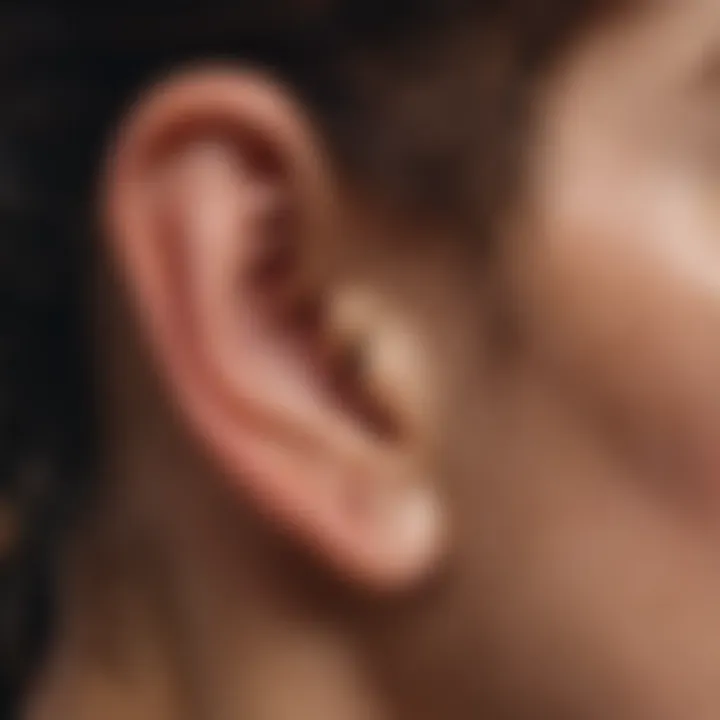
Intro
A ruptured eardrum is not just a mere inconvenience; it can lead to a range of issues that can hinder your daily activities. Understanding the signs of this condition is pivotal for those who often engage in water-related activities like swimming, diving, or even just enjoying a day at the beach. Recognizing the symptoms early can facilitate swift medical intervention, which sometimes is the difference between a quick recovery and ongoing complications.
When we talk about the eardrum, or the tympanic membrane as it's formally known, it's important to understand its role in ear health. This thin membrane separates the outer ear from the middle ear and is critical for the proper functioning of hearing. A compromised eardrum can lead to hearing loss, balance issues, and even infections. Common causes include trauma from a sudden loud noise or pressure changes during altitude shifts in flight, or a simple ear infection left untreated.
In this exploration, we will delve into the myriad of signs that indicate a potential rupture, the associated risks and consequences, and essential steps one should take upon noticing these signals. Furthermore, we will cover preventative measures one can adopt, especially if you're a water enthusiast. Knowing the warning signs can save not just your hearing but preserve your overall well-being.
Let’s break it down further.
Overview of Eardrum Functionality
Understanding the functionality of the eardrum is crucial in recognizing the signs of an injury, particularly a rupture. The eardrum, or tympanic membrane, serves as the boundary between the outer ear and the middle ear. It plays a vital role not just in hearing but also in maintaining the balance of pressure within the ear, which is essential for optimal auditory perception.
The eardrum vibrates when sound waves hit it, converting these mechanical waves into vibrations that are further transmitted to the ossicles – the tiny bones in the middle ear. This transmission is the first step in the process that ultimately allows us to perceive sound. Without a properly functioning eardrum, one may experience diminished hearing abilities, making it difficult to engage in conversations or enjoy music, especially for those who participate in sports or social activities where communication is key.
Furthermore, the integrity of the eardrum plays a role in protecting the inner ear from infections and foreign bodies. When it is compromised due to a rupture, the risk of ear infections increases significantly, leading to further complications. Therefore, recognizing the signs of a ruptured eardrum becomes not just about understanding hearing loss, but also about acknowledging the risk of additional health issues.
"The eardrum is often taken for granted until something goes amiss – but it's a frontline defender in both hearing and ear health."
Overall, familiarizing oneself with the functionality of the eardrum can provide insights into potential issues and motivate proactive health measures, especially for those involved in physically demanding or adventurous activities.
Anatomy of the Ear
The anatomy of the ear is intricate and fascinating, encompassing three major parts: the outer ear, middle ear, and inner ear. The outer ear consists of the visible structures, including the pinna and the ear canal, which direct sound waves toward the eardrum. The middle ear contains the eardrum and three tiny bones known as the ossicles: the malleus, incus, and stapes. These bones amplify vibrations from the eardrum and convey them to the inner ear. Finally, in the inner ear lies the cochlea and the vestibular system, which are crucial for hearing and balance.
The eardrum itself, a thin membrane about 0.1 mm thick, is made of three layers: a skin layer, a fibrous layer, and a mucous layer. Its unique construction allows it to vibrate freely and efficiently, making it vital for sound transmission.
Role of the Eardrum in Hearing
The role of the eardrum in hearing cannot be overstated. Upon receiving sound waves, it vibrates in sympathy with those waves, creating mechanical energy. The vibrations from the eardrum then travel through the ossicles and into the inner ear, where they are transformed into nerve impulses decoded by the brain. This transformation is instantaneous but intricate, relying heavily on the eardrum's health.
Causes of Eardrum Rupture
Understanding what leads to a ruptured eardrum is pivotal. Recognizing the causes not only helps in preventing this injury but also guides in ensuring proper treatment if it occurs. Everything from common infections to physical impacts can contribute to this condition. Here, the focus will be on the specifics—those elements that shed light on how, why, and what can be done.
Infections and Illnesses
One of the prime culprits behind eardrum rupture is infections, particularly those affecting the upper respiratory system. When you catch a nasty cold or suffer from sinusitis, fluid can build up behind the eardrum. This pressure can create a perfect storm for a rupture. In children especially, the risk is heightened as their Eustachian tubes are smaller and not as effective at equalizing pressure.
Conditions such as otitis media, an inflammation of the middle ear, can push the eardrum beyond its limits. If you notice a sudden sharp pain in the ear, along with hearing loss, it could signal an infection that's got worse. This underscores the importance of treating ear infections promptly.
Physical Trauma
Accidents can happen to anyone, and when it comes to ear injuries, physical trauma stands out. Imagine getting smacked in the ear during a game of dodgeball, or maybe you're an adventure seeker who took a wrong turn while kayaking. These jolts can transmit shock waves that rupture the eardrum.
Even loud sounds, like a gunshot or an explosion, can cause your eardrum to rupture from sudden pressure changes. In short, whether involved in daily sports or extreme activities, awareness of your surroundings is crucial. It doesn't take much for a small incident to result in what could be a significant injury.
Pressure Changes
The science behind pressure changes is fascinating yet crucial for ear health. The ears are incredibly sensitive to changes in pressure, whether caused by altitude shifts, such as ascending in an airplane, or diving underwater. When pressure in the external environment differs from the pressure in the middle ear, the eardrum can bulge outward or inward.
For those who fly frequently or dive regularly, recognizing the signs of imbalance is key. Things like ear popping or discomfort while changing elevations can be indicators that your ears aren't equalized properly. If left unaddressed, you run the risk of not just discomfort but actual rupture.
Foreign Objects
Sometimes, it's the unexpected that can cause harm. Inserting foreign objects into the ears—whether it be cotton swabs, a hairpin, or even small toys in the hands of a curious child—can lead to direct physical trauma. These objects can scratch or puncture the eardrum, resulting in considerable injury.
It's vital to keep ears clean using safe methods. When cleaning, avoid inserting anything into the ear canal itself, as the risk of injury far outweighs any perceived benefits. Educating yourself, as well as those around you, can save a world of trouble down the line.


"A little knowledge can go a long way in preventing injuries that could have been easily avoided."
Pain and Discomfort
Experiencing pain and discomfort is typically the most immediate indicator that something is amiss. The pain can vary in intensity, often described as sharp or stabbing, which may worsen with changes in altitude, such as during flights or when diving underwater. This sensation results from the eardrum's inability to effectively transmit sound waves due to its damage, leading to increased pressure and discomfort in the ear canal.
Many might brush off mild pain, thinking it will resolve on its own, but it’s vital to pay close attention. If the discomfort becomes persistent or increases in severity, it’s crucial to seek medical advice. Ignoring it could lead to further complications.
"Always listen to your body. Pain is often a warning sign, not just an inconvenience."
Fluid Drainage from the Ear
Fluid drainage from the ear is another telltale sign of a eardrum rupture. In most cases, if the eardrum is significantly compromised, you may notice strange fluids, which could be clear, bloody, or even pus-like, depending on the underlying cause. This draining can be alarming, but it comes as a result of your body’s attempt to heal itself.
When there’s a rupture, fluids may leak from the middle ear into the outer ear. If you see this happening, it’s essential not to stick anything into your ear in hopes of cleaning it out. Instead, tampering with this can introduce bacteria and lead to chronic infections. Always prioritize a visit to a healthcare professional when you experience fluid drainage, as they can examine the situation properly.
Hearing Loss
Hearing loss is often gradual following a ruptured eardrum, though this isn’t a universal experience. Many individuals may notice muffled sounds or certain frequencies affecting their ability to hear clearly. This threshold shift in hearing is a direct result of either partial or complete loss of the eardrum’s function.
Interestingly, it’s not just volume that gets compromised; clarity can also take a hit. Sounds may blend together, making it difficult to discern speech or recognize familiar musical notes. For those with active lifestyles, this decline can have significant consequences, particularly in team sports where communication is essential. If sudden hearing loss accompanies the other physical signs, it is imperative to seek medical attention immediately.
Auditory Symptoms of Eardrum Injury
Auditory symptoms play a crucial role in identifying a damaged eardrum. These symptoms not only highlight the condition but also provide insight into the severity of the injury. Recognizing these auditory cues is essential for prompt treatment, helping to mitigate further complications. When the eardrum is ruptured, various sound-related disturbances can manifest, and understanding these changes can greatly aid in seeking appropriate medical attention.
Tinnitus: Ringing in the Ears
One of the most common auditory symptoms tied to a ruptured eardrum is tinnitus, often described as a persistent ringing or buzzing sound in the ears. This symptom can range from mildly bothersome to intensely disruptive. Tinnitus can occur due to the injury itself or as a result of inflammation in the surrounding ear structures.
"Experiencing tinnitus for the first time can feel unsettling, and recognizing it as a possible sign of a serious issue can prompt individuals to seek medical advice sooner."
For those who are involved in loud environments, such as musicians or coaches at sporting events, this symptom can be particularly alarming. Not only does it affect one's ability to hear, but it can also distract from tasks, making it essential to monitor.
Distorted Sounds
In addition to tinnitus, individuals with a compromised eardrum may notice that sounds are distorted. This often presents as muffled auditory experiences, where conversations sound unclear, or familiar sounds become confusingly altered. Such changes can result from the loss of balance in pressure and sound transmission due to the perforation in the eardrum.
This can hinder one's ability to interact in social settings or focus on critical tasks, increasing frustration. It's important for adventure seekers, especially those engaged in noisy activities, to be aware of how their auditory perception can shift. Being attuned to these signs encourages a deeper understanding of ear health, allowing enthusiasts to better manage their wellbeing.
Sensitivity to Noise
Another auditory symptom that individuals may face following an eardrum injury is sensitivity to noise, also known as hyperacusis. This heightened sensitivity makes normal sounds feel overwhelmingly loud, leading to discomfort or even pain. Such a condition can create barriers for those in loud environments, like athletes or instructors.
Preventing exposure to sharp noises becomes vital, as it can exacerbate feelings of discomfort. To illustrate, a coach trying to motivate during a game may find themselves in a tough spot if everyday cheering feels unbearable. Recognizing these auditory symptoms can assist in making informed decisions regarding participation in noisy events.
In summary, being mindful of auditory symptoms such as tinnitus, distorted sounds, and noise sensitivity can significantly serve as indicators of a damaged eardrum. Promptly addressing these issues can pave the way for effective treatment and recovery, allowing individuals to continue pursuing their passions without the looming threat of hearing complications.
Complications Arising from a Ruptured Eardrum
The concern over a ruptured eardrum often extends beyond the immediate symptoms. This section highlights the potential complications that can arise if the condition is left unaddressed or mismanaged. For those involved in sports, adventure activities, or any water-related pursuits, understanding these implications can foster a proactive approach to ear health, ensuring that minor issues don’t escalate into severe complications.
Chronic Ear Infections
One of the most common problems following an eardrum rupture is the increased risk of chronic ear infections. When the eardrum is breached, bacteria and viruses can more easily enter the middle ear space, leading to otitis media. This condition can be both painful and inconvenient, often manifesting with symptoms like persistent ear pain, drainage, or even fever. Sports enthusiasts who frequently find themselves in swimming pools or open water are particularly vulnerable.
- Key Points to Consider:
- Regular ear infections may lead to tissue change over time.
- Symptoms may include irritation and inflammation, which could detrimentally impact hearing.
- Prevention methods, such as keeping ears dry, become crucial in mitigating this risk.
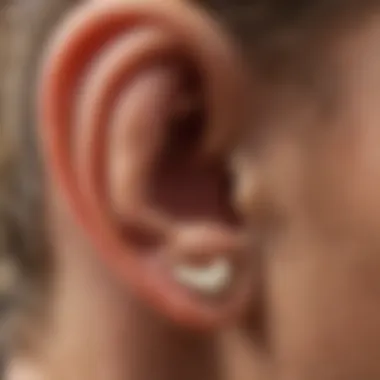
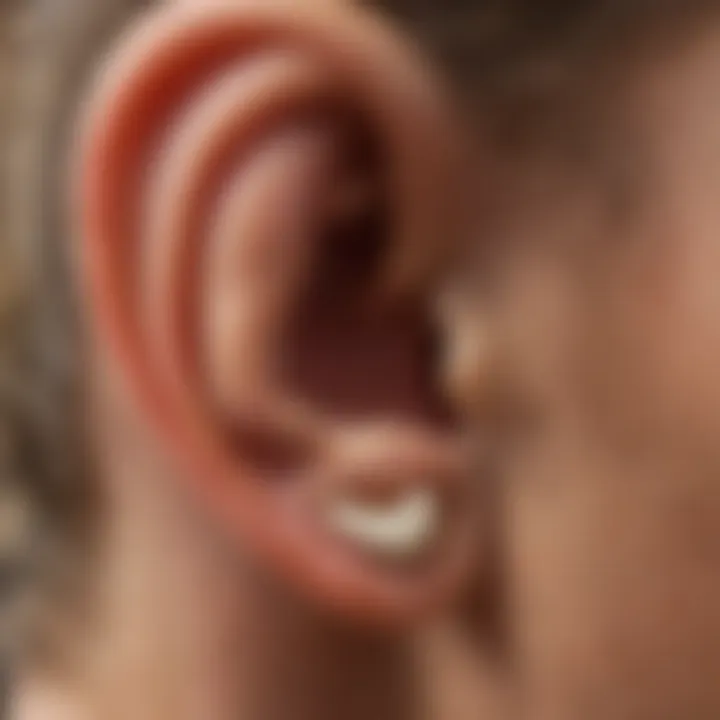
Permanent Hearing Loss
Another serious consideration is the risk of permanent hearing loss. The eardrum plays a essential role in transmitting sound vibrations to the inner ear. A rupture may cause those vibrations to be distorted or muffled, potentially leading to lasting impairment. For adventure seekers who rely on sharp auditory awareness—like hearing incoming waves while surfing or detecting distant sounds during hiking—this impact can be especially significant.
"Hearing is one of our most vital senses, especially when engaging in high-action environments. A subtle sound could make all the difference between safety and danger."
- Chronic issues related to eardrum perforation can directly affect the inner ear structures.
- Regular check-ups are encouraged to prevent irreversible damage.
- Audiometric evaluations after recovery can help determine the extent of any loss.
Balance Issues and Dizziness
Lastly, balance issues and feelings of dizziness can be concerning after a ruptured eardrum. The ear is not only responsible for our ability to hear but also plays a role in our vestibular system, which helps maintain balance. When the eardrum is compromised, it can disrupt the inner ear structures associated with equilibrium. This disruption can lead to dizziness or a sensation of spinning, known as vertigo. For individuals who enjoy sports that demand agility, such as rock climbing or skiing, these symptoms can pose significant safety risks.
- Recognizing these symptoms is crucial:
- Unsteady movements can lead to falls or other accidents during physical activity.
- It is vital to avoid risky activities until a thorough evaluation and recovery.
Diagnostic Approaches
Recognizing the signs of a ruptured eardrum is only half the battle; understanding how to properly diagnose the condition is just as critical. When we talk about diagnostic approaches, we're discussing the various methods and techniques that healthcare professionals use to assess whether the eardrum has sustained damage. This section is key, particularly for sports enthusiasts and adventure seekers who are often exposed to conditions that could compromise ear health.
Effective diagnostic techniques not only help in identifying an issue but also guide treatment decisions. By understanding the methods employed in this arena, individuals can appreciate the steps involved in obtaining a clear diagnosis and subsequent care.
Clinical Examination Techniques
One of the first steps in diagnosing a ruptured eardrum is through clinical examination techniques. This does not require high-tech gadgets and can often be performed right in the doctor's office. It usually involves a straightforward inspection using an otoscope — a tool equipped with a light and magnifying lens.
During the examination, the healthcare provider carefully looks into the ear canal to see the eardrum directly. They'll check for signs which might include:
- Redness or inflammation: A normal eardrum should appear translucent and gray. Any swelling or reddening could indicate damage.
- Holes or perforations: A clear indication of a ruptured eardrum is the presence of a visible hole in the membrane.
- Fluid presence: The presence of blood or pus behind the eardrum can signal not just a rupture but also the possibility of an infection.
These examination techniques are often quick and can yield immediate insights. The healthcare provider's experience in interpreting these signs adds another layer of expertise that is crucial in determining the next steps.
Imaging Studies
In cases where the examination may not provide conclusive results or if there are complications suspected, imaging studies might be necessary. While not always used, these studies can be crucial for further investigation.
Common types of imaging studies that are relevant include:
- CT Scans: These provide detailed images of the ear structure and can help assess the extent of the injury. They are especially useful when complications such as fractures of the skull are concerned.
- MRI: Though less common for ear issues, an MRI might be employed if soft tissue damage is suspected.
Taking advantage of modern imaging technology not only aids in confirming diagnoses but can also help in uncovering underlying conditions that could exacerbate the situation. In many instances, this additional data guides more nuanced treatment plans.
Therefore, when someone suspects an eardrum rupture, understanding the importance of these diagnostic approaches can feel empowering. Knowledge leads to timely interventions, reducing the risk of complications down the line.
With these diagnostic strategies in mind, individuals can better prepare themselves should the need arise for ear health evaluation. Proper understanding paves the way for effective action, especially for those engaged in adventurous activities, where ear injuries could become a real concern.
Treatment Options
Recognizing the potential for a ruptured eardrum and its various signs is only half the battle. Once those signs start popping up, knowing the right treatment options becomes crucial. Untreated or improperly managed cases can lead to a cornucopia of complications. Therefore, understanding the nuances surrounding treatment offers significant benefits, including pain relief, preservation of hearing, and prevention of further complications.
Conservative Management
Conservative management refers to the initial approaches that prioritize non-invasive methods to address a ruptured eardrum. For many individuals experiencing symptoms like pain and mild hearing loss, this might often be the preferred route.
Here are some major elements to consider:
- Pain Management: Over-the-counter pain relievers, such as ibuprofen or acetaminophen, can help alleviate discomfort associated with an eardrum rupture. It’s essential to use these medications as directed to avoid any potential side effects.
- Antibiotics: If the rupture is caused by an infection, a healthcare provider might prescribe antibiotics. This can help to control the infection and prevent it from exacerbating the condition.
- Avoiding Water Entry: One cardinal rule during recovery: keep water out of the ears. Bathing or swimming can worsen the issue, particularly if the eardrum is not fully healed. Patients should use earplugs or a shower cap to avoid submersion.
- Rest and Observation: Allowing the body to naturally heal can be effective. Most mild ruptures can mend without surgical intervention over a few weeks.
In the context of preventive care, adopting these conservative strategies facilitates a smoother healing process. Each person's journey to recovery can differ, influenced by the severity of the rupture and individual response to treatment. However, it’s prudent to consult a healthcare provider before commencing any treatment, to ensure the methods align with specific needs and conditions.
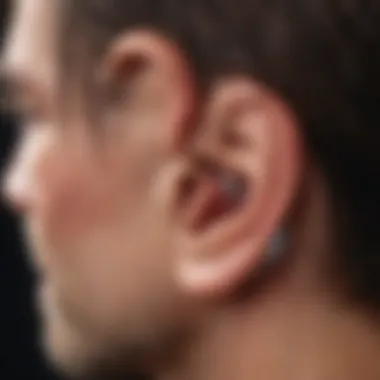
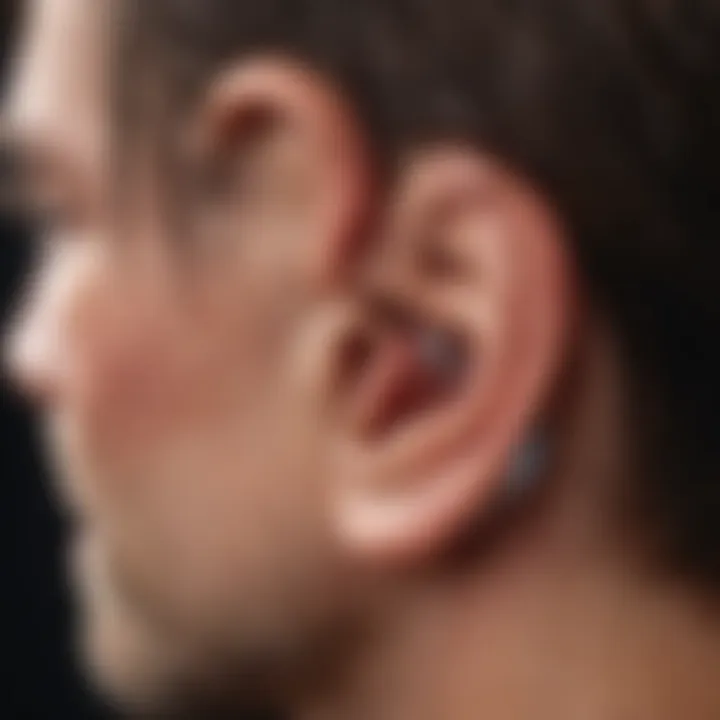
Surgical Interventions
While many ruptured eardrums can heal on their own, some cases might call for more intensive measures. Surgical interventions play a pivotal role when conservative methods do not yield the desired results or complications arise.
Key considerations include:
- Tympanoplasty: This surgical procedure involves reconstructing the eardrum using different types of grafts. It’s generally recommended in cases with significant hearing loss or persistent problems after a rupture that hasn’t healed on its own.
- Ear Tube Insertion: In cases of recurring infections or chronic ear issues, healthcare providers might recommend placing tubes in the ear canal to assist with drainage and pressure regulation. This aids in preventing future ruptures.
- Addressing Underlying Issues: Surgical options can also include addressing any structural problems in the ear that may have contributed to the eardrum rupture. This could involve cleaning out fluid or debris that could cause infections.
In summary, having surgical options can provide a safety net for those who may experience complications from a ruptured eardrum. The timing and necessity of such interventions should be discussed with a qualified ear, nose, and throat specialist.
Seeking appropriate treatments early can make all the difference in your recovery journey. Don’t hesitate to reach out to a healthcare professional if you suspect a ruptured eardrum.
Preventive Measures for Ear Health
Protecting ear health is not just about knowing how to react when something goes wrong; it's about being proactive. This article seeks to equip readers with essential preventive measures to maintain ear health, particularly for individuals engaged in sports and adventure activities. Being aware of how certain practices can lead to injury is a critical component of a comprehensive ear care strategy.
Protective Strategies for Watersports
Watersports enthusiasts often find themselves exposed to conditions that can put their eardrums at risk. Here are some strategies to keep your ears safe:
- Use Earplugs: Invest in quality earplugs designed for water activities. They prevent water from entering the ears, reducing the chances of infections and potential ruptures.
- Avoid Diving Without Precautions: When diving, it’s crucial to equalize pressure in the ears frequently. Descending too fast without adjusting can cause extreme pressure differences, potentially leading to a burst eardrum.
- Stay Informed About Water Conditions: Before engaging in any water activities, confirm if the water is safe and clean. Contaminants can exacerbate ear infections, putting you at higher risk.
- Dry Your Ears Thoroughly: After every swim, dry your ears thoroughly. Tipping your head to let water out or using a towel to remove moisture can help prevent problems.
Awareness of Environmental Factors
The environment we inhabit can significantly influence ear health. Here’s what to keep in mind:
- Watch for Allergens: Pollens, dust, and other allergens can lead to ear infections. If you know you are allergic, take appropriate measures such as using antihistamines or air purifiers in your home.
- Avoid Loud Noises: Chronic exposure to loud sounds can damage the delicate structures of the ear, increasing the risk for eardrum problems. Wear ear protection when in loud environments.
- Be Mindful of Pressure Changes: Flying or diving creates rapid changes in pressure. Make it a practice to chew gum or yawn during takeoff and landing in an airplane to equalize pressure effectively.
- Check Humidity Levels: Low humidity can dry out nasal passages and lead to congestion, which can affect ear health. Use a humidifier in dry environments to maintain optimal moisture levels.
"An ounce of prevention is worth a pound of cure"—taking the time to implement these strategies can save you a trip to the doctor.
Integrating these preventive measures into your routine not only helps in avoiding injuries but also promotes long-term ear health stability. Awareness and preparedness are key to avoiding issues that might arise from casual exposure to water and environmental elements.
When to Seek Medical Attention
Determining when to get medical help for a possible ruptured eardrum is crucial. Recognizing key symptoms can make the difference between a simple recovery and serious, lasting issues. Being aware of specific signs that indicate a pressing need for medical assessment is paramount, especially for those active in sports and outdoor activities where ear trauma may be common.
Recognizing Urgent Signs
When dealing with ear issues, certain symptoms should raise a red flag. Here are some urgent signs that suggest immediate medical attention:
- Severe Pain: If the pain in your ear escalates beyond discomfort, this could be a sign of a serious condition requiring treatment.
- Persistent or Heavy Fluid Drainage: While some drainage may occur naturally, any significant or continuous flow of bloody or pus-filled fluid tells you it's time to see a doctor.
- Sudden Hearing Loss: A rapid decrease in your ability to hear, especially after an injury, should never be ignored. This may indicate severe damage to your auditory system.
- Dizziness or Balance Problems: If you experience vertigo or feel unsteady, this can suggest inner ear involvement, potentially complicating the situation further.
- Fever: A rise in body temperature, particularly coupled with ear symptoms, is a red flag indicating infection or inflammation.
- Tinnitus: An increase in ringing or buzzing sounds in your ears that appears suddenly or intensifies may signal rupture or damage.
Remember: Ignoring these signs can lead to complications such as chronic ear infections or even permanent hearing loss. Always err on the side of caution!
Ultimately, your ears, much like any other part of your body, deserve proper attention when issues arise. If you find yourself facing any of the symptoms mentioned above, don't hesitate. A trip to the doctor can help ensure your health remains in check and can steer you away from more severe complications. The sooner a professional evaluates your condition, the better your chances for a swift and complete recovery.
Ending: Understanding Ear Health
Awareness of one’s ear condition can pave the way for effective preventive measures. Those engaged in activities such as swimming, diving, or even coaching in volatile environments must stay vigilant about the signs of ear issues. Whether it is understanding the subtleties of ear pain, fluid drainage, or hearing impairments, each symptom provides valuable insight.
Moreover, the insights shared are invaluable for fostering a culture of proactivity. Individuals should cultivate habits that safeguard ear health, ensuring that they don’t merely react when symptoms arise but actively seek to strengthen their awareness and knowledge. Integrating ear health practices into daily life can yield numerous benefits including reduced risk of complications like chronic infections or permanent hearing loss.
As discussed, the road to better ear health includes developing solid understanding:
- Recognizing when to seek medical help: If discomfort arises, swift action can mitigate long-term damage.
- Embracing routine check-ups: Just like you’d make an appointment for dental health, don’t overlook ear health.
Ultimately, every individual has a role to play in their well-being. Considering the impact of eardrum ruptures highlights not just an immediate concern, but a broader narrative of self-care and education regarding auditory health.
“An ounce of prevention is worth a pound of cure.”
Awareness today leads to better outcomes tomorrow.
Integrating Knowledge into Daily Practices
Utilizing the knowledge gained about ear health can significantly enhance one’s lifestyle, particularly for those who frequently engage in activities that risk ear injury. Integrating ear care into daily routines is not just wise, it’s essential. Here are some practical ways to implement this knowledge:
- Protective Ear Gear: Utilize specialized earplugs for swimming or diving to keep excess water and pressure away from the eardrum.
- Infection Awareness: Keep an eye out for any upper respiratory infections or allergies. Addressing these early may prevent subsequent ear complications.
- Regular Check-Ups: Schedule annual visits with an audiologist or ENT, especially if you’re engaged in high-risk sports.
- Educate Others: Share your knowledge with fellow coaches or athletes. Raising awareness within your community can be beneficial for collective ear health.
These practices aren’t just precautionary. They encourage a mindset of care and vigilance that empowers individuals, allowing them to actively participate in their own health journey.







